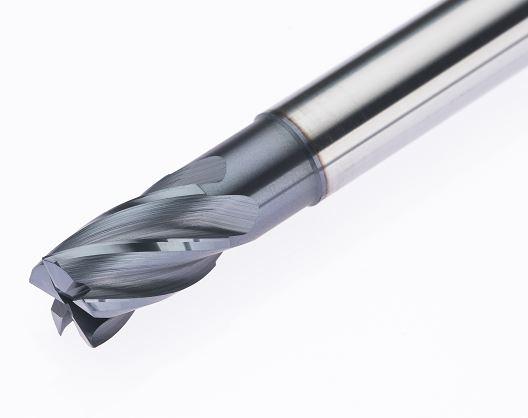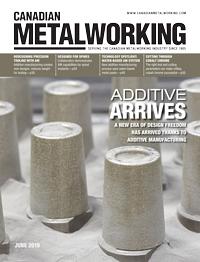Associate Editor
- FMA
- The Fabricator
- FABTECH
- Canadian Metalworking
Cutting through cobalt chrome
The right tool and cutting parameters can make milling cobalt chrome successful
- By Lindsay Luminoso
- June 11, 2019
- Article
- Cutting Tools

Emuge’s TiNox-Cut product range consists of submicron grain carbide end mills for difficult-to-cut materials, particularly aerospace materials. Photo courtesy of Emuge.
Manufacturers in the orthopedic and dental implant sectors are familiar with difficult-to-machine materials like cobalt chrome. These superalloys are known for their biocompatibility, making them a great choice for medical device manufacturing. Even the aerospace industry has taken note of the unique characteristics and high degree of hardness that cobalt chrome offers. As this material becomes more mainstream, machine shops have to adapt to meet the challenges when milling this hard-to-cut material, particularly because the cost of cobalt chrome is quite high.
CHARACTERISTICS
"Cobalt chrome is considered a DTC [difficult-to-cut] material due to its high hardness, corrosion resistance, high melting points, and incredible strength at high temperatures," said Chris Foschaar, application and sales engineer, Horn USA Inc., Franklin, Tenn. Foschaar added that there are many variations of the material, with an average hardness of 40-50 HRC. Depending on the type of cobalt chrome, the material also can carry hard spots throughout upwards of 58-60 HRC.
Adding to the fact that this material is difficult to mill, the hard spots also can lead to inconsistent machining results. According to Cory Cetkovic, product manager, Big Kaiser, Hoffman Estates, Ill., it is important to take note of these hard spots in the material and determine the most appropriate tool to handle a range of hardnesses within the material.
Beyond these characteristics, cobalt chrome is heat-treatable, not magnetic, offers good hot and cold formability, and has high coefficient of thermal expansion and very high resistance to acid, making these alloys a great fit for dental equipment, medical tech, the energy sector, chemical industries, and aerospace.
"These materials also can be polished at an extremely high level, which eliminates surface areas where bacteria can form in medical devices," said Dan Doiron, milling product manager, Emuge Corp., West Boylston, Mass.
CHALLENGES
There are several challenges that operators should be aware of when milling cobalt chrome. The material tends to be extremely abrasive, which causes the cutting tools to dull prematurely and reduces the life of the tool.
"This in turn causes the next challenge, which is work hardening of the material," said Foschaar. "These challenges can be minimized by selecting the proper cutting tools for the application."
Another significant consideration is that cobalt chrome is very heat-resistant with low thermal conductivity. During cutting of standard steels, heat generally is evacuated through the chip. However, with cobalt chrome, heat does not generate into the chips.
Because of this, the heat concentrates at the cutting edge of the tool," said Doiron. "This is where the geometry of the tool plays a big role in its ability to absorb that heat and chip away the material. Also, when working with cobalt chrome, establishing proper cutting parameters is vital to prevent tool failure."
Proper cooling at the cutting edge, reducing tool projections as much as possible, and using a very strong, rigid fixture setup on the machine will help deal with the challenges of milling cobalt chrome. With the high price of the material, ensuring process reliability through proper tool selection and cutting parameters is essential.

Horn’s Torus end mill is carbide grade TSCC for machining of cobalt chrome alloys. It comes with a 2- to 5-fluted design with a 30-degree helix angle. Photo courtesy of Horn.
CUTTING TOOLS
Using the appropriate cutting tools is essential to optimizing cutting conditions for cobalt chrome. According to Cetkovic, one of the biggest cutting tool considerations should be strength of the tool design. He recommends starting with a reinforced shank diameter. Choosing a milling tool geometry with a positive break angle will reduce cutting forces and deflection, which tend to be problematic with this material.
Foschaar added that solid-carbide tools are preferred for machining cobalt chrome materials. Carbide cutting tools generally have thermal shock-resistant properties while at the same time have a high degree of bending strength and fracture toughness, making them suited for the characteristics of this material.
"Tools designed for nickel-based alloys or tools for hardened materials are also suitable for this material," said Foschaar. "Nose end mills or square end mills with corner radii are usually ideal for this material. It’s also important that the tools are sharp. Dead sharp tools should be avoided due to the rapid decline of the cutting edge, which will cause rubbing, and a work-hardening situation will occur."
Beyond substrate, geometry, and edge prep, adding a coating can be a big asset. Cetkovic explained that a coating can have a huge influence on chip evacuation, which is extremely important in this heat-resistant material.
"We are able to take a lot of our more common tool geometries and apply a special coating or put a radius on the edge to help them perform in some of these more difficult-to-machine materials," he added.
Doiron added that it’s not just the cutting tools themselves that an operator needs to consider. Having a rigid setup with the cutting tool fully inserted into the toolholder to the maximum depth is an optimal scenario. If an operator can keep the tool engaged in the holder to the correct gauge line, tool wear can be reduced, which is already a significant challenge even without overextending the tool.
OPERATING PROCEDURE
"Enhancing the efficiency of machining cobalt chrome can be accomplished by keeping a close eye on the tool life, for all the tools in the process, and frequently changing tools to ensure that you are cutting the material and not rubbing the material with dull tools," said Foschaar. "Most times cutting parameters are drastically reduced in this material to avoid poor tool life, but there is a fine line or small window to machine within for cobalt chrome."
Cetkovic added that operators need to be aware of the high work-hardening rate of this material. He suggests that a slow feed rate, although better for cutting tool life, could also result in this work hardening, so it’s important to discuss with cutting tool manufacturers the range of cutting speeds (SFM) that the tool can handle in the material. To extend tool life, he also recommends a low depth of cut.
"We also tend to see some variability when it comes to coolant delivery," said Cetkovic. "We’ve also seen a large number of cases where customers are dry machining these materials."
This is generally because of the low thermal conductivity of the material. Cetkovic explained that when cutting, the tool will absorb a lot of the heat. Adding coolant as the tool exits the cut can cause it too cool down quickly, which can cause the tool to fracture because of thermal shock. Machining cobalt chrome dry can help operators avoid situations like this.

Big Kaiser’s end mills are designed to increase productivity and meet some of the most challenging application requirements. These micro cutting tools are produced using solid carbide with a reinforced shank to maximize stability. Photo courtesy of Big Kaiser.
FINAL CONSIDERATIONS
"I think everyone who cuts this material, or at least has been in the industry, understands how difficult it is," said Doiron.
He explained that for operators or shops that haven’t come across it or are now just starting to get into it, they may find it very disappointing because of the SFM rating and tool life expectancy. However, once a shop has worked out the correct machining parameters and knows how to approach the material, it can successfully machine cobalt chrome and get the best tool performance.
Associate Editor Lindsay Luminoso can be reached at lluminoso@canadianmetalworking.com.
Big Kaiser, www.bigkaiser.com
Emuge, www.emuge.com
Horn USA Inc., www.hornusa.com
About the Author

Lindsay Luminoso
1154 Warden Avenue
Toronto, M1R 0A1 Canada
Lindsay Luminoso, associate editor, contributes to both Canadian Metalworking and Canadian Fabricating & Welding. She worked as an associate editor/web editor, at Canadian Metalworking from 2014-2016 and was most recently an associate editor at Design Engineering.
Luminoso has a bachelor of arts from Carleton University, a bachelor of education from Ottawa University, and a graduate certificate in book, magazine, and digital publishing from Centennial College.
Related Companies
subscribe now


Keep up to date with the latest news, events, and technology for all things metal from our pair of monthly magazines written specifically for Canadian manufacturers!
Start Your Free Subscription- Trending Articles
Automating additive manufacturing

Identifying the hallmarks of a modern CNC

CTMA launches another round of Career-Ready program

Collet chuck provides accuracy in small diameter cutting

Sandvik Coromant hosts workforce development event empowering young women in manufacturing

- Industry Events
MME Winnipeg
- April 30, 2024
- Winnipeg, ON Canada
CTMA Economic Uncertainty: Helping You Navigate Windsor Seminar
- April 30, 2024
- Windsor, ON Canada
CTMA Economic Uncertainty: Helping You Navigate Kitchener Seminar
- May 2, 2024
- Kitchener, ON Canada
Automate 2024
- May 6 - 9, 2024
- Chicago, IL
ANCA Open House
- May 7 - 8, 2024
- Wixom, MI















